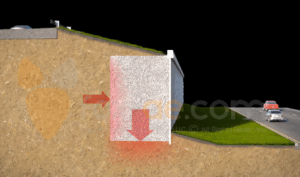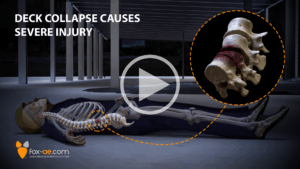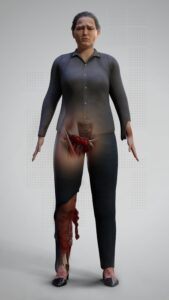Ensuring justice is served can be challenging in the complex legal system. However, technological advancements have paved the way for an innovative solution: legal animation. This powerful tool can potentially revolutionize the justice system and prevent wrongful convictions.
Legal animation brings complex legal cases to life, presenting evidence and recreating events in a visually engaging and persuasive manner. By using animation, attorneys can simplify and clarify complex information, making it easier for judges, jurors, and even the general public to understand. This not only helps to prevent misunderstandings but also ensures that vital details are not overlooked during trials.
Legal animation can recreate crime scenes, depict witness testimonies, and visualize scientific evidence, providing a clearer picture of what transpired. Presenting this information in a compelling and unbiased manner reduces the chances of wrongful convictions while giving a voice to the innocent.
In this article, we will explore the power of legal animation in preventing wrongful convictions and discuss its potential to bring about positive change in the justice system.
Wrongful convictions: Understanding the problem
Wrongful convictions represent a significant failure within the justice system, where innocent individuals are found guilty of crimes they did not commit. This troubling issue is not merely a statistical anomaly; it affects real lives, families, and communities, leading to devastating consequences. The factors contributing to wrongful convictions are multifaceted, including unreliable eyewitness testimonies, inadequate legal representation, and the misinterpretation or mishandling of forensic evidence. As a result, these miscarriages of justice undermine public trust in the legal system and highlight the urgent need for reform and innovative solutions.
One of the most alarming aspects of wrongful convictions is the sheer number of cases that have been identified over the years. Organizations like the Innocence Project have worked tirelessly to exonerate wrongfully convicted individuals, often revealing systemic flaws in the legal process. Factors such as police misconduct, prosecutorial pressure, and the influence of race and socioeconomic status can lead to biased outcomes. Moreover, the emotional and psychological toll on those wrongfully accused can be profound, resulting in lifelong trauma and stigma, even after dismissal. Understanding the breadth and complexity of this problem is essential for identifying effective preventive measures.
Addressing wrongful convictions requires a multifaceted approach encompassing education, legal reforms, and incorporating technology in the courtroom. By utilizing advanced tools like legal animation, the legal system can enhance the presentation of evidence and create a more accurate portrayal of events. This innovative approach can facilitate more precise communication between legal professionals, jurors, and the public, ultimately fostering a more just and equitable legal process. As we delve deeper into the role of legal animation, it is essential to recognize its potential in addressing the critical issue of wrongful convictions.
The role of legal animation in preventing wrongful convictions
Legal animation plays a vital role in addressing the complexities of the justice system, particularly in preventing wrongful convictions. By transforming intricate legal narratives into engaging visual representations, legal animation assists attorneys in conveying their arguments more effectively. This technology allows for the recreation of crime scenes, the visualization of witness accounts, and the presentation of forensic evidence in a manner that is accessible and easily understood. When jurors can see a visual representation of the case, they are more likely to grasp the nuances, leading to more informed decision-making.
In addition to enhancing comprehension, legal animation can also serve as a powerful tool for identifying inconsistencies in testimonies. By presenting animated reconstructions of events, attorneys can highlight contradictions between witness statements and the evidence. This capability not only strengthens the defense but also contributes to a fairer trial process, as it encourages the examination of all evidence critically. Legal animation provides an unbiased method of illustrating the facts, reducing the chances of jury misinterpretation and, ultimately, wrongful convictions.
Furthermore, legal animation fosters a more empathetic understanding of the events surrounding a case. By visually depicting a crime’s emotional and psychological aspects, jurors can connect with the human experience behind the evidence. This emotional engagement can be crucial in cases where the stakes are high, as it encourages jurors to consider the broader implications of their decisions. By incorporating legal animation into trials, the justice system can ensure that all voices, especially those of the wrongfully accused, are heard and represented adequately.
How legal animation works
Legal animation involves a systematic process that transforms raw data and evidence into compelling visual narratives. The first step typically involves gathering relevant materials, including police reports, photographs, witness statements, and forensic analyses. Subsequently, this information is analyzed to determine the critical elements depicted in the animation. Collaboration between legal teams and animation professionals is essential at this stage, as it ensures that the final product aligns with the case’s legal strategy and accurately represents the events in question.
Once the information has been consolidated, the animation team begins the creative process. This involves storyboarding, where the sequence of events is mapped out visually. Depending on the case’s needs, the animation can range from simple diagrams illustrating timelines to complex 3D recreations of crime scenes. Using sophisticated software and artistic techniques, animators can create realistic representations that capture the events’ physical environment and emotional context. This level of detail is crucial for conveying the gravity of the situation to jurors and judges alike.
After creating the animation, it undergoes rigorous review and revision to ensure accuracy and compliance with legal standards. The final product is presented in court as part of the trial proceedings. Legal animation can be used in various ways, such as during opening statements, witness examinations, and closing arguments. Its visual nature not only aids in comprehension but also enhances retention, ensuring jurors are more likely to remember critical aspects of the case. As a result, legal animation serves as a powerful ally in the pursuit of justice, fostering a clearer understanding of complex legal narratives.
Benefits of using legal animation in criminal trials
The integration of legal animation into criminal trials offers a myriad of benefits that enhance the judicial process. One significant advantage is the ability to simplify complex information. Legal cases often involve intricate details that can be challenging for jurors to understand. By translating these details into visual formats, legal animation makes it easier for jurors to grasp essential elements of the case. This simplification promotes more transparent communication and reduces the likelihood of confusion or misinterpretation during deliberations.
Another notable benefit is the increased engagement of jurors. Traditional presentations of evidence can sometimes lead to disengagement or boredom, especially when dealing with lengthy legal jargon. Legal animation, on the other hand, captivates attention and maintains interest, encouraging jurors to invest more mentally in the proceedings. When actively engaged, jurors are more likely to absorb information effectively, which can result in more thoughtful and informed verdicts.
Moreover, legal animation can be valuable for fostering transparency and trust in the legal system. By providing a neutral and unbiased representation of the evidence, legal animation helps to ensure that all parties involved are treated fairly. This transparency can enhance public confidence in the judicial process, as citizens witness a commitment to thoroughness and accuracy. In an era of mistrust of the legal system, adopting innovative tools like legal animation can play a pivotal role in rebuilding faith in justice.
Challenges and limitations of legal animation
While legal animation presents numerous benefits, it is essential to recognize the challenges and limitations associated with its use. One primary concern is the potential for bias. Animations can inadvertently skew perceptions of evidence or events if not executed carefully. For instance, the creative decisions made during the animation process can introduce subjective elements that may not accurately reflect reality. This risk necessitates a collaborative approach between legal teams and animation professionals to ensure that the final product remains as factual and unbiased as possible.
Additionally, the cost of producing high-quality legal animations can be a significant barrier for some legal teams, particularly in cases involving limited budgets. The complexity and intricacy of the animations can lead to substantial expenses, which may not always be feasible for public defenders or low-income defendants. As a result, the disparity in resources available to different legal teams can impact the equitable application of this technology in the justice system.
Finally, legal professionals must continue to receive proper training in utilizing legal animation effectively. As this technology evolves, attorneys must understand how to integrate animations into their cases strategically. A lack of familiarity with the medium can lead to ineffective presentations that do not capitalize on the potential advantages of legal animation. Ensuring that legal professionals are well-versed in this innovative tool is crucial for maximizing its impact in pursuing justice.
The future of legal animation in the justice system
The future of legal animation in the justice system appears promising as technological advancements continue to expand its capabilities. As software and tools become more sophisticated, the potential for creating more realistic and immersive animations will increase. This evolution will allow for even more detailed recreations of events, enhancing the ability of legal teams to present their cases compellingly. As the field of legal animation matures, it is likely to become a standard component of legal practice, particularly in complex criminal cases.
Furthermore, integrating virtual reality (VR) and augmented reality (AR) technologies into legal animation could revolutionize how evidence is presented in court. These technologies can deepen understanding and engagement by allowing jurors to experience crime scenes from multiple perspectives or interact with visual elements. Such immersive experiences could transform the courtroom dynamic, enabling jurors to form more nuanced opinions based on their virtual experiences of the evidence.
As the legal community becomes more aware of the benefits of legal animation, there is a growing push for its adoption across various jurisdictions. Advocacy for legal reform may lead to increased accessibility of legal animation for all defendants, regardless of their financial resources. By promoting equitable access to this technology, the justice system can ensure that every individual has the opportunity to present their case effectively, thereby reducing the likelihood of wrongful convictions and fostering a more just society.
Conclusion: The impact of legal animation on the criminal justice system
Integrating legal animation into the criminal justice system holds significant promise for preventing wrongful convictions and enhancing the overall fairness of trials. By providing clear, engaging, and unbiased representations of complex evidence, legal animation helps jurors and judges grasp the nuances of cases that may otherwise be difficult to understand. Adopting innovative technologies like legal animation will be crucial in promoting transparency, equity, and justice as the legal landscape evolves.
Moreover, as public awareness of wrongful convictions grows, the demand for effective solutions will likely increase. Legal animation stands out as a powerful tool that can address many of the justice system’s challenges. Ensuring that all individuals, regardless of their circumstances, have access to high-quality legal representation can significantly reduce the risk of wrongful convictions.
In conclusion, legal animation’s ongoing development and implementation can potentially transform the judicial process. By embracing this technology, the legal community can work towards a future where justice is served more reliably and the voices of the innocent are heard. The journey towards a fair and effective justice system is ongoing, but with innovative solutions like legal animation, there is hope for a brighter future.





